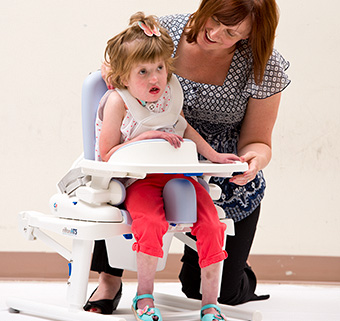 For many parents and teachers of children with special needs, toilet training can seem like an unattainable goal.
For many parents and teachers of children with special needs, toilet training can seem like an unattainable goal.
Each child has unique health issues, physical disabilities, emotional/behavioral challenges, cognitive and learning disabilities as well as communication barriers. Nevertheless, an individualized, consistent toileting routine can have great positive impact on quality of life, whether or not complete continence or total toilet training success is achieved.
How to begin? Here are 8 toileting tips from the Continence Foundation of Australia that have proven their worth for toileting success.1
1. Seek advice from a health professional.
Medical advice from a physician or specialist is essential to address any obvious concerns. It is important to first rule out or resolve any significant medical problems such as diarrhea, constipation, urinary tract and bowel infections, coeliac disease, or perhaps bowel or bladder defects.2,3
An occupational therapist or physical therapist can offer positioning advice with the use of an adaptive toilet seat if a child is unable to maintain a sitting position on the toilet independently. A child who is struggling to maintain an upright posture on the toilet will not be able to relax and concentrate on the task at hand.4
A behavioral specialist or psychologist may have good input for a child who displays adverse behaviors such as sensory stimulation of the “product” – smearing feces is not uncommon in young children with autism. Or a child may be alarmed by the loud flushing noise in the bathroom. The removal of the pamper or clothing for toileting may induce a sudden change in temperature and the tactile feeling of clothes off, causing insecurity.5
An occupational therapist or speech therapist may have recommendations regarding a visual schedule or specific cues for the sequence and tasks of toileting.5,6 Recommendations are also available for children with visual or hearing impairments.7
2. Consider your child’s daily diet and fluid intake.
Children with special needs may have bouts of constipation or infrequent or difficult bowel movements. Children with low muscle tone or with spastic abdominal muscles may have difficulty contracting their muscles to achieve elimination. Lack of being in an upright position and decreased physical exercise can contribute to constipation as well. A physician, gastroenterologist, nutritionist, feeding specialist or dietician can offer advice regarding a child’s diet and medications.
A high–fiber diet with plenty of fluids is the most natural way to treat constipation. Whole grains, fruits and vegetables are good sources of fiber. Other foods such as bananas, sweets, white bread, fast food and foods with high fat or dairy content may slow down digestion.8 Of course, food effects will vary between children.
Nevertheless, during toilet training, make sure your child drinks plenty of fluids and has a diet that includes fiber to assure that bowel movements will not be hard. One hard, painful bowel movement may be a significant setback for a child learning to be cooperative with a toileting routine.
Keeping regular mealtimes will help your child’s stomach, bowels and bladder to be empty and full at regular intervals. Not only that, but food tends to stimulate the bowel, so over time, it may be possible to predict bowel habits based upon mealtimes.
3. Modify the toilet and bathroom environment.
For children who are non-ambulatory, careful planning is needed to assure safe transfers or perhaps to incorporate skill–building for sit–to–stand practice with upright toileting.3,9
Children with special needs may need to sit longer to achieve complete voiding. A feeling of instability may be one of the primary reasons children with disabilities resist sitting on the toilet. For many children, a simple seat insert and foot stool may be sufficient to allow the child to comfortably maintain balance. Others need an adaptive toileting seat to provide positioning stability and optimal positioning for successful elimination.10
This short video offers a discussion of the optimal toilet position:
A quiet bathroom environment without distractions, noises or smells that may cause discomfort or anxiety is important. Without interruption, the child can give the task full attention and demonstrate success. Other children may require music, a storybook or a toy to encourage them to remain sitting for the length of time necessary for the toilet opportunity.
Recommendations from a physical therapist, occupational therapist or behavioral specialist can be very helpful.
4. Set daily toilet time routines.
It is important to set a daily toilet routine. Even a slight progress toward independence with fewer daily accident, can help maintain bowel and bladder health and have a major impact on quality of life.
Successful toileting has two aspects: staying dry between toileting sessions, and successful voiding in the toilet.
Certain timed toileting schedules recommend an opportunity every half hour or hourly, with emphasis on the child’s awareness of being wet versus dry, and with rewards and encouragement to the child that result in gradually extending the time that he or she manages to stay dry. In time, the child may even develop awareness of the need to go, and learn to communicate this. This approach is often recommended for children with autism.11
Other scheduled toileting routines establish toilet times that are on a regular basis, day–to–day. These times are manageable, sustainable, and very consistent. The focus is to celebrate and reward each time the child voids in the toilet or pan. This habit training can be surprisingly successful over time, and a child may eventually choose to hold the urine until the next toilet opportunity. This approach can be successful with children with significant physical and cognitive challenges.12 Consistent use of an associated object or picture symbol can eventually establish this scheduled time with the child’s receptive understanding of toilet time.5
For best success, a Toilet Record Chart is very helpful. In the case of more frequent timed toileting, with the goal to stay dry, it can be helpful to document the previous fluid or food intake (i.e., time and amount). Added space allows for documentation of any comment or concern, such as the level of cooperation or perhaps a diarrhea or constipation episode.
By carefully reviewing the Toilet Record Chart, parents and supporting health professionals can rule out or address any medical concerns and further assist with schedule planning. There are many tools, charts, and record-keeping forms available on the internet that can be adapted for each child’s situation.6, 11, 12, 13 Here are two samples.
Write down the time that the child is on the toilet, and whether the child’s pampers are wet/dry, and whether the child voided urine/bowel movement in the toilet. When reviewing the Toilet Record Chart, circle or highlight the incidents when the child urinated or was wet, and see if a daily pattern can be found. Specific scheduling at these times can promote success.
Be sure that toileting remains a positive and happy time. If there is any resistance, do not force the child. Rather, seek the help and advice of a behavioral specialist or psychologist.
5. Use clear communication cues.
Children with disabilities may have difficulty communicating their needs. A child may also lack receptive communication, and may not understand an adult’s communications about the idea or process of using the toilet. Behavior may be an issue, or sometimes it is simply lacking awareness of “I’m wet!” In fact, a child simply may not have the ability to interpret body sensations to understand the need to use the toilet.
Speech therapists and behavioral specialists can offer methods to help shape toileting behavior and enable communication. Strategies will be unique to each child. When parents or caregivers all use the same simple and clear words or phrases, then the child will be more likely to understand expectations for the toileting process. Picture symbols can be effective for many children. For others, hand gestures will communicate best.
The parent or care provider directs the child to the toilet and through the toileting routine with gentle physical guidance as needed. Although a toileting opportunity may be provided at any time, such as when there is an obvious need or when an accident occurs, it is still important to revert to scheduled toileting. Of course, the exact schedule can always be adjusted if deemed necessary on review.
Through observation, parents and teachers may learn to interpret body language and non-verbal cues that indicate the “need to go.” Once a child becomes more aware of being wet or soiled, he or she may want to void in the toilet and stay dry. A child may eye–point in the direction of the toilet, or become agitated, pull at clothing or cry. He or she may even walk or maneuver their wheelchair to the bathroom. Eventually (and this may take months or years), the child may learn to verbally request, or use a gesture, picture symbol or eye gaze to request to use the toilet.
6. Manage wetting and soiling as a positive teaching opportunity.
Debbie Atkins, occupational therapist and toilet training consultant with the Continence Foundation of Australia, gives guidance as follows:
“If wetting and soiling does occur, then always move to the bathroom and include a toilet sitting time as part of any clean up routines. Keep your interactions calm and neutral; there is no praise or rewards at these times, but avoid any reprimands or punishment. Instead, view this as a positive teaching opportunity to practice the usual toileting routine with your child.”
View at 06:07 in this video.
Continence Foundation of Australia. (September 22, 2016.) Toileting Tips for Children and Young People with a Developmental Disability. [Video].
7. Be consistent.
The more consistent the toilet routine, the better, also between caregivers. This includes the bathroom environment, and the sequence of tasks, words used, or means of communication. You will be amazed at how repetition and familiarity can promote a child’s learning.
Agree together how best to reward the child’s success in staying dry or voiding in the toilet. Each child is unique in how their accomplishment may be best celebrated, whether through a visual or audible (or edible) encouragement, or through a physical or sensory reward that is reserved for this moment. Positive reinforcement and praise are great teachers.
8. Allow time.
A child with special needs probably will not perform immediately upon being seated on the toilet. It is OK to allow a toilet opportunity for up to ten to fifteen minutes, depending on your child’s comfort level with prolonged sitting. Guidance from a trusted healthcare professional or behavioral specialist is important here.
It is unlikely that a child with special needs will fully understand and perform the toileting process in a matter of weeks or months. In most cases, success with toileting or toileting continence may only be achieved after months or years. Children with special needs have undeniable developmental challenges. It is important for us to keep our expectations realistic. However, with patience and persistence, there is no telling how far your child may go.
Back to Top** This post was originally published on http://www.rifton.com/adaptive-mobility-blog/blog-posts/2020/may/toileting-concepts-special-needs-child

